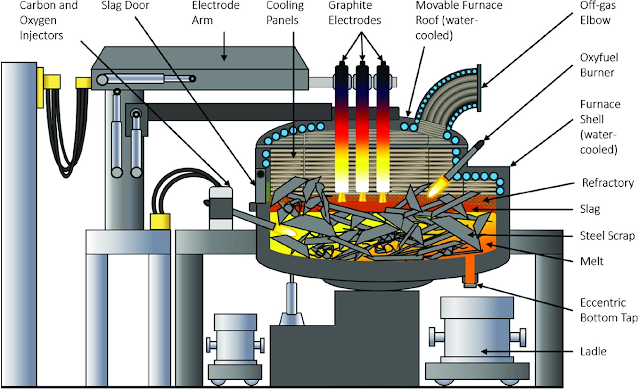EAF steelmaking
Advantages: by arc heating, high thermal efficiency, can adjust the furnace atmosphere, compared with open-hearth, converter, less capital investment, small area.
Disadvantages: the arc is a point heat source, high consumption of power, electrode and refractory, low productivity, and higher cost than the converter.
Introduction of traditional basic electric arc furnace steelmaking method and process flow.
Common smelting methods: generally can be divided into oxidation method, non-oxidation method, and return oxygen blowing method.
Oxidation process: after the furnace charge is melted, the operation of dephosphorization and decarbonization is carried out by adding ore or blowing oxygen into the molten steel, resulting in the boiling of the molten pool, removing [H], [n] gas, and non-metallic inclusions in the steel, and then tapping after deoxidization and decarbonization in the reduction period, adjusting the chemical composition and temperature of the molten steel. The characteristic of this method is that it can reduce [P], [S], [H], [n], [O] in steel to the specification range, so as to achieve the purpose of purifying liquid steel. Therefore, most steel grades are smelted by this method. The disadvantage of this method is that if there are a lot of alloying elements in the steel, it will cause oxidation loss and bring adverse effects on the operation. Therefore, carbon scrap is often used in general batching, which causes difficulties in later alloying.
Non-oxidation method: there is no oxidation period in the smelting process, which can fully recover the alloy elements in raw materials. After the burden is melted, the composition and temperature can be adjusted by reduction. The utility model has the advantages that a large amount of alloy steel cutting head, tail, scrap ingot, injection residue, soup channel, chip, etc. can be added into the furnace charge to reduce the consumption of ferroalloy and the cost of steel. The disadvantage is that it is impossible to remove P, gas, and inclusion in the smelting process, so it is required to add clean, rust-free, oil-free steel with low P and suitable C content, and to prevent excessive suction of liquid steel during smelting.
Return oxygen blowing method: a large amount of alloy steel return material is added to the furnace charge. According to the theory that the affinity of C and O is greater than that of some alloy elements and o at a certain temperature when the temperature of molten steel rises to a certain temperature, oxygen is blown into the molten steel, so as to achieve the purpose of decarbonization, degassing and impurity removal, and at the same time, the oxidation loss of alloy elements in the steel can be avoided. This not only reduces the cost but also improves the quality.
Free send inquiry to stella@hanrm.com if any needs.
Whatsapp/Wechat:+8615877652925
Website: https://www.hanrm.com
Furnace Transformer – Electric Arc Furnace
Melting Features of Medium Frequency Electric Furnace
Electric Arc Furnace VS The Intermediate Frequency Furnace
What are the Advantages and Disadvantages of Blast Furnace?
Characteristics of Electric Arc Furnace Steelmaking
Walking Beam Reheating Furnace VS Push-steel Reheating Furnace
Why Intermediate Frequency Furnace cannot be Turned on Normally?






.jpg)







